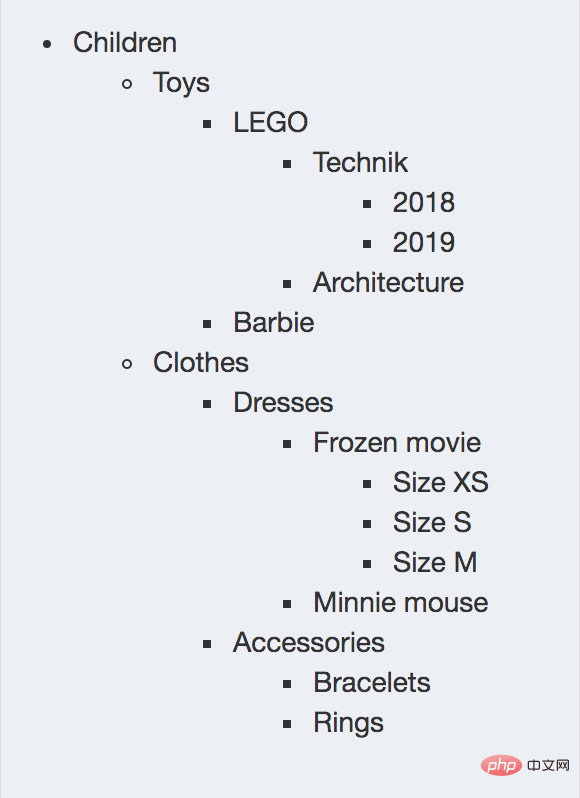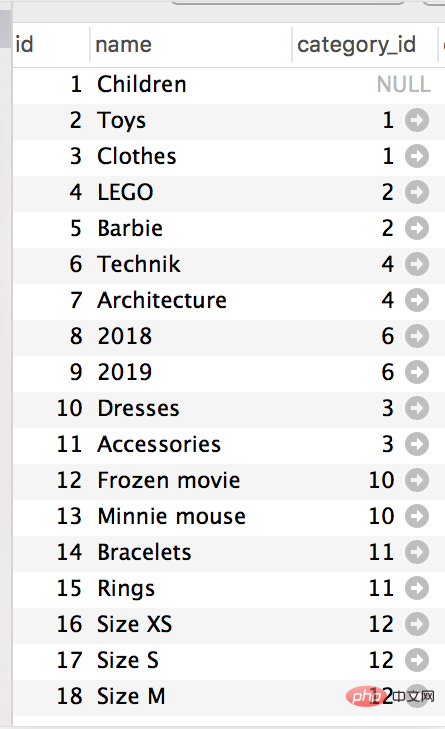Using Laravel Eloquent's hasMany to develop Infinitus classification
The following is developed by LaravelThe introductory tutorial column will introduce you to the method of using Laravel Eloquent's hasMany to develop Infinitus classification. I hope it will be helpful to friends in need!
In online shopping malls, we can often see multi-level classifications, sub-categories, and even Infinitus classifications. This article will show you how to elegantly implement it with Laravel Eloquent.
We will create a micro project to display the classification of children's stores, with a total of 5 levels, as follows:

Database migration
Simple data table structure:
Schema::create('categories', function (Blueprint $table) {
$table->bigIncrements('id');
$table->string('name');
$table->unsignedBigInteger('category_id')->nullable();
$table->foreign('category_id')->references('id')->on('categories');
$table->timestamps();
});There is only one name field, related to itself. Therefore, most parent categories category_id = NULL, and each subcategory has a parent_id
The data table data is as follows:

##Eloquent model And the relationship
First, create a simple hasMany() method in app/Category.php. The category may have its own self-categorization:class Category extends Model
{
public function categories()
{
return $this->hasMany(Category::class);
}
}public function childrenCategories()
{
return $this->hasMany(Category::class)->with('categories');
}Routes and Controller Methods
Now, let us try to display all categories and subcategories as shown in the above example. In routes/web.php, we add the following:Route::get('categories', 'CategoryController@index');
public function index()
{
$categories = Category::whereNull('category_id')
->with('childrenCategories')
->get();
return view('categories', compact('categories'));
}Views and recursive subviews
Finally, render to the page. In the resources/views/categories.blade.php file:<ul>
@foreach ($categories as $category)
<li>{{ $category->name }}</li>
<ul>
@foreach ($category->childrenCategories as $childCategory)
@include('child_category', ['child_category' => $childCategory])
@endforeach
</ul>
@endforeach
</ul><li>{{ $child_category->name }}</li>
@if ($child_category->categories)
<ul>
@foreach ($child_category->categories as $childCategory)
@include('child_category', ['child_category' => $childCategory])
@endforeach
</ul>
@endifThe above is the detailed content of Using Laravel Eloquent's hasMany to develop Infinitus classification. For more information, please follow other related articles on the PHP Chinese website!

Hot AI Tools

Undresser.AI Undress
AI-powered app for creating realistic nude photos

AI Clothes Remover
Online AI tool for removing clothes from photos.

Undress AI Tool
Undress images for free

Clothoff.io
AI clothes remover

Video Face Swap
Swap faces in any video effortlessly with our completely free AI face swap tool!

Hot Article

Hot Tools

Notepad++7.3.1
Easy-to-use and free code editor

SublimeText3 Chinese version
Chinese version, very easy to use

Zend Studio 13.0.1
Powerful PHP integrated development environment

Dreamweaver CS6
Visual web development tools

SublimeText3 Mac version
God-level code editing software (SublimeText3)

Hot Topics
 How to get the return code when email sending fails in Laravel?
Apr 01, 2025 pm 02:45 PM
How to get the return code when email sending fails in Laravel?
Apr 01, 2025 pm 02:45 PM
Method for obtaining the return code when Laravel email sending fails. When using Laravel to develop applications, you often encounter situations where you need to send verification codes. And in reality...
 Laravel schedule task is not executed: What should I do if the task is not running after schedule: run command?
Mar 31, 2025 pm 11:24 PM
Laravel schedule task is not executed: What should I do if the task is not running after schedule: run command?
Mar 31, 2025 pm 11:24 PM
Laravel schedule task run unresponsive troubleshooting When using Laravel's schedule task scheduling, many developers will encounter this problem: schedule:run...
 In Laravel, how to deal with the situation where verification codes are failed to be sent by email?
Mar 31, 2025 pm 11:48 PM
In Laravel, how to deal with the situation where verification codes are failed to be sent by email?
Mar 31, 2025 pm 11:48 PM
The method of handling Laravel's email failure to send verification code is to use Laravel...
 How to implement the custom table function of clicking to add data in dcat admin?
Apr 01, 2025 am 07:09 AM
How to implement the custom table function of clicking to add data in dcat admin?
Apr 01, 2025 am 07:09 AM
How to implement the table function of custom click to add data in dcatadmin (laravel-admin) When using dcat...
 Laravel Redis connection sharing: Why does the select method affect other connections?
Apr 01, 2025 am 07:45 AM
Laravel Redis connection sharing: Why does the select method affect other connections?
Apr 01, 2025 am 07:45 AM
The impact of sharing of Redis connections in Laravel framework and select methods When using Laravel framework and Redis, developers may encounter a problem: through configuration...
 Laravel multi-tenant extension stancl/tenancy: How to customize the host address of a tenant database connection?
Apr 01, 2025 am 09:09 AM
Laravel multi-tenant extension stancl/tenancy: How to customize the host address of a tenant database connection?
Apr 01, 2025 am 09:09 AM
Custom tenant database connection in Laravel multi-tenant extension package stancl/tenancy When building multi-tenant applications using Laravel multi-tenant extension package stancl/tenancy,...
 Laravel Eloquent ORM in Bangla partial model search)
Apr 08, 2025 pm 02:06 PM
Laravel Eloquent ORM in Bangla partial model search)
Apr 08, 2025 pm 02:06 PM
LaravelEloquent Model Retrieval: Easily obtaining database data EloquentORM provides a concise and easy-to-understand way to operate the database. This article will introduce various Eloquent model search techniques in detail to help you obtain data from the database efficiently. 1. Get all records. Use the all() method to get all records in the database table: useApp\Models\Post;$posts=Post::all(); This will return a collection. You can access data using foreach loop or other collection methods: foreach($postsas$post){echo$post->
 Laravel database migration encounters duplicate class definition: How to resolve duplicate generation of migration files and class name conflicts?
Apr 01, 2025 pm 12:21 PM
Laravel database migration encounters duplicate class definition: How to resolve duplicate generation of migration files and class name conflicts?
Apr 01, 2025 pm 12:21 PM
A problem of duplicate class definition during Laravel database migration occurs. When using the Laravel framework for database migration, developers may encounter "classes have been used...






